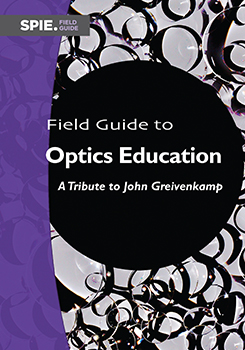A Classical Approach to Teaching Light–Matter Interaction
Eric Van Stryland and David Hagan
University of Central Florida, USA
One of the authors (EVS) had a teacher in his third year of college who said that the most important problem in physics was the simple-harmonic oscillator (SHO). As the years have gone by, the truth of his statement has continued to be reinforced. Teaching a course on the interaction of light with matter can be greatly facilitated by spending considerable time teaching aspects of the damped, driven SHO. Modeling matter as “electrons on springs” provides remarkable insight into absorption and refraction in atomic/molecular/semiconductor/dielectric materials:
When teaching a course in this area, it is useful to include in the first lecture a computer simulation of the solution of the SHO equation of motion. Rather than focusing on the temporal growth of the oscillator versus time after a harmonic force is turned on (e.g., turning on a laser), we show several aspects of the steady-state solution while varying the frequency of the driving force. This shows the amplitude and phase with respect to that of the driving force of oscillation going through resonance. Using this model for electron displacement (or nuclear displacement for vibrations) allows for calculation of the polarization with the electron density N, giving the optical susceptibility:
Along with the relationship ɛ(ω) = 1 + χ(ω) this allows for discussion in some detail of the complex Lorentz optical susceptibility, absorption and refraction, 2-level atoms and optical transitions, Lorentzian line shapes, polarization, metals and Drude theory, vibrations, plasma frequency, and the dielectric function from which we can calculate the transmission, reflection, and absorption of some sample material. Some key points about χ(ω) are (see figure):
1. The maximum amplitude is in resonance at ω ≈ ω0 and is purely imaginary.
2. At resonance, the phase difference between E and r is 90 deg.
3. At high frequencies (ω ≫ ω0), the amplitude of χ(ω) goes to 0.
4. At low frequencies (ω ≪ ω0), a finite real amplitude of is obtained.
Once this model has been discussed for bound (Lorentz) and free (Drude) electrons, we extend it to vibrations in molecules and phonons in crystals, which are again closely related to the SHO. The model even extends to the modes of cavities (e.g., to describe the density of states in semiconductors/dielectrics) and thus black-body radiation. And this model can be easily extended to nonlinear optics by adding a small term in the restoring force that is proportional to a higher-order of r, e.g., r2.
These models allow for discussion of other concepts, such as local field correction factors, Kramers–Kronig relations, Sellmeier equations, etc. It is remarkable that so much of light–matter interaction can be described without the need for quantum mechanics. Although many of these approaches can occasionally be found in condensed matter or spectroscopy texts, there are a few textbooks on light–matter interaction that follow this approach, notably Hopf and Stegeman,1 Wooten,2 and Fox.3
References1. F. A. Hopf and G. I. Stegeman, Applied Classical Electrodynamics, Vol 1: Linear Optics, Wiley (1985).
2. F. Wooten, Optical Properties of Solids, Academic Press (1972).
3. M. Fox, Optical Properties of Solids, Oxford University Press (2003).



